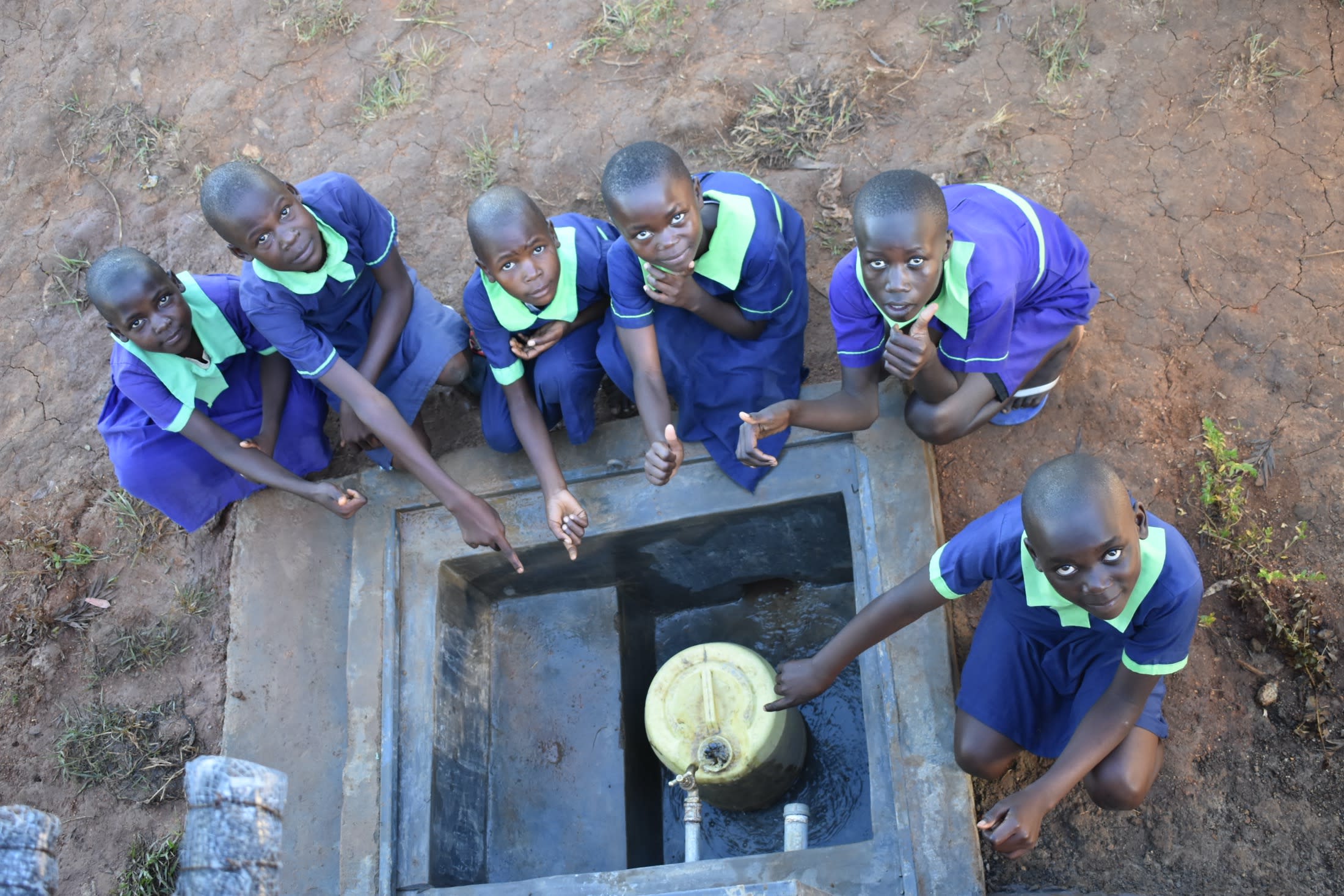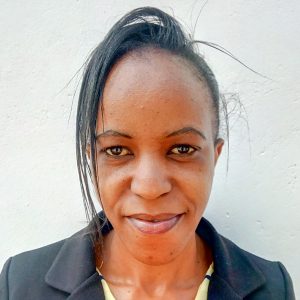March, 2020: Khwihondwe SA Primary School Project Complete!
Please note, all photos in this report were taken before social distancing recommendations went into place.
Khwihondwe SA Primary School in Kenya now has access to a new source of safe, clean water thanks to the completion of their rain tank, which has the ability to collect 75,000 liters of water! We installed new latrines and handwashing stations for students, and we trained students and staff on improved sanitation and hygiene practices. All of these components work together to unlock the opportunity for these students to live better, healthier lives.

Girls fetch water from the rain tank
"No more feeling tired and even sometimes fatigued because of carrying water to school daily and at the same time being expected to concentrate in class for lessons. I will now be able to concentrate on my classwork without anything interfering,'' said pupil Iyvone.
"Since we will no longer be carrying water or going to fetch water during or before class time, personally I know and believe that I'm going to perform well academically and achieve my dream of joining the best secondary school outside Kakamega since I was born here in Kakamega. Therefore my dream is to join a school that performs well so that I will be able to achieve my goal of becoming a doctor."

Pupil Iyevone
"Maintaining cleanliness in our school had been hard since we had not enough water, but now that this water point is within the school, our classes are going to be clean and even the latrines, too. Pupils also will be clean since there will be no dust within our classes, and also pupils will be in the position of cleaning their hands with clean water when they visit the latrines and even before eating anything," she added.
Teachers were just as excited as the students about the new rain tank on campus.
"My health now is assured of its safety. This is because I have a history of waterborne disease effects. For a very long time I have been avoiding taking water around here," said Principal Bernard Rwafibi.

Principal Rwafibi stands on school grounds surrounded by materials in use during the construction phase of the rain tank and latrines
"The school has been wasting a lot of time searching for water and even lacked time for morning preps, but now this water point will help us improve on academics and achieve high grades which will also attract more pupils from neighboring schools. This water point will also help me achieve the goal of pupils having both morning and evening preps without any interference and also for them to be able to attend lessons even during the weekends."

A young brother helps his little sister get a drink
"Their meals will be prepared here at school for classes 7 and 8 unlike before when we couldn't introduce it because of water. I will now be able to settle down conflicts that have been here almost every time between the school and parents of pupils who carried their parents' jerrycans without permission and did not return them. This is because having the water point with us here, pupils will no longer carry those jerrycans bringing them here into the school."

Rain Tank
Construction for this 75,000-liter rain tank was successful!
Parents, staff, and students helped our artisans gather everything needed for construction. All the while, the school cooks and community members prepared meals for the artisans, and the school provided accommodations for the artisans during their work. Local women and men helped our artisans with their manual labor, too.

Students help deliver construction materials to school
The process officially began with our staff and school administration looking around the school compound to try and determine the best location for a new rain tank. This needed to be the best site with enough land and a nearby building with good, clean roofing to catch the rainwater.

Excavating the tank foundation site
Then, we cleared the site by excavating the soil to make level ground for the tank foundation. The foundation was cast by laying big stones on the level ground and reinforcing them using steel wire, concrete, and waterproof cement. Both the drawing pipe as well as the drainage pipe were affixed as the foundation was laid.

Casting the foundation and fitting the wire skeleton to the edges
Next, the walls were formed using a skeleton of rebar and wire mesh with sugar sacks temporarily tied to the outside as backing. This was attached to the foundation’s edges so that the work team could start the Ferro-cementing process, in which the walls are layered with cement alternating with the inner and outer side until 6 layers of cement are in place. (The sugar sacks are removed once the interior receives its first 2 layers of cement.)

Sugar sacks tied to outside of tank skeleton
Inside the tank, 1 central and 4 support pillars were cast to ensure the dome does not fall down once cemented. Meanwhile, the inner wall was plastered while the outer walls received their roughcasting. Outside of the tank, the access area to the tap was dug, plastered, and a short staircase installed, along with a soak pit where spilled water can drain from the access area through the ground. This helps to keep the tap area dry and tidy.

Cementing work inside the tank with just 1 of 5 pillars cast so far
Dome construction could begin after the tank walls had been given enough time to settle. Using similar techniques as used on the walls, the dome started as rebar, wire mesh, and sugar sacks and was attached to the tank walls before receiving cement and plaster. A small manhole cover was built into the dome to allow access for future cleanings and water treatments.
Long wooden poles (about 75 of them!) were placed inside the tank to support the dome while it cured. A lockable manhole cover was fitted over the tap area, the gutters were affixed to the roof and the tank, and an overflow pipe was set in place at the edge of the dome for when the tank reaches capacity.

Dome cementing underway
During the implementation process, parents would pass nearby the school's fence and whenever they passed they stood and made comments on how the tank will attract many pupils to come and join the school, as well as saying that the new projects have shaped the school, making it look newer and more attractive. One passerby brought her 2 grandsons to the school. She went directly to the principal's office to register the 2 boys for school, and then came straight over to Field Officer Betty Mwangi, who was managing the project.
"I have brought my grandchildren here the moment I saw the construction of this tank begin. This is an assurance of our children's good health," the grandmother said.

Once finished, the rain tank was given 3-4 weeks to undergo complete curing. Finally, the interior support poles and dome sugar sacks were removed, the tank was cleaned, and we waited as rain filled the tank with fresh water. When there was a sufficient volume in the tank, we treated the water and we officially handed it over to Khwihondwe SA Primary School.

Head Teacher gives speech during handing over celebration
As soon as it was ready, students and staff celebrated the presence of clean water on campus. The event was a great chance for us to acknowledge the school administration and students as the primary parties entrusted with the tools we have given, as well as remind them of our continued support as they develop. Happiness, thanksgiving, and appreciation were the order of the day flowing in all directions.

A parent gives a speech and vote of thanks for the project
The celebration was attended by many people, and each group wanted to make a speech to share their thanks and excitement about the project. A group of students even prepared a poem titled "No Water, No Life" which they performed in front of the whole crowd (check out the video on the photos tab of this project page to see it!).

The handing over ceremony between our staff (Field Officer Betty Mwangi and Team Leader Emmah Nambuye Wekesa on right), pupils, and school staff
During the handing over ceremony, the head teacher spoke of how having the presence of the water facilities in the school helped the school get easy access to registration for the national examinations since they are having their first candidates sit for their national exams this year. Previously, the school was not able to register since the school had been given a closure letter last year due to lacking proper sanitation facilities.
The head teacher also added that congestion during break times will no longer be present in the latrines, and also the issue of insecurities especially for the girl child whenever the school demanded water outside the school will be passed. The happiness on the faces of the pupils, teachers, and their parents both during the implementation and after the project's completion could not hide their feelings of joy for the presence of the water tank in the school.

"'No water, No life!" said sanitation and hygiene teacher Sabina Matswa, sharing a comment sentiment and theme of the day.
"Access to unsafe water is also dangerous in our bodies. Having access to this water point, it is a great assurance of our health since we have been worried every time our cook prepared our meals and even tea for our breakfast because nobody knew the source of water brought in by our pupils. I feel safe now because most of the time I have been feeling dehydrated whenever I'm at school because I usually carry little water and once it was finished, I suffered a lot so my life will be safe now," she said.

"Life assurance is one of the goals we are going to achieve since the water in the tank will be treated and we are sure that it is safe for our lives. Another plan that I have as a sanitation and hygiene teacher is that our environment is going to be unique in that I will follow up on cleanliness with much ease because there will be enough water in the school to clean."
VIP Latrines
This project funded the installation of 6 new ventilated improved pit (VIP) latrines, half for girls and half for boys.

Girls pose outside their new VIP latrines
All of these new latrines have cement floors that are designed to be easy to use and clean. And with a rain tank right on school property, there should be enough water to keep them clean.

Boys pose with their new VIP latrines
Handwashing Stations
The 2 handwashing stations were set up during training and handed over to the student health club. These were placed outside of the girls’ and boys’ latrines to encourage handwashing after latrine use. Health club members will teach other students how to properly wash their hands at the stations, make sure the stations are filled with water, and work to ensure that there is always a cleaning agent such as soap or ash available.
New Knowledge
Hygiene and sanitation training was scheduled with the help of the school principal, who ensured that the training date would be convenient for students, staff, and parent representatives. Individual teachers helped by selecting students from each class to represent the others. When the training day arrived, facilitators Betty Mwangi, Linna Akuku, Jacky Kangu, Adelaide Nasimiyu, and Elvine Atieno deployed to the site.
26 people attended training. The training venue was a cool and conducive environment for learning since it was inside a classroom.

A student rises to give an answer during training
We covered a number of topics including personal hygiene such as bathing, oral hygiene, and the 10 steps of handwashing; environmental hygiene; child rights; operation and maintenance of the rain tank, latrines, and handwashing stations; and leadership and governance. During the latter, the students elected their peers to lead their newly formed student health club.
This group of students was unique in that most of the participants voluntarily wanted to be leaders and did not need much encouragement from their peers. The facilitator used animal characters to discuss the traits of different people and kinds of leaders to help the students choose their leaders wisely. This brought much laughter whereby the pupils could make jokes for each animal given. The sanitation teacher came up with an idea that when voting, every respondent would put their head down on their desk and raise their hand to choose their preferred leaders.

Training participants
The students were so determined for their positions of choice, which was very enjoyable and encouraging to see. One boy who wanted to be treasurer was told to please move outside so that the rest could vote. Even while he was moving out he was begging his fellows to vote for him! After voting had ended, all of the chosen leaders stood before the rest and shared how they were to lead the group on taking care of their new WaSH facilities.
The club will be greatly involved in the water, sanitation, and hygiene project management at school and will be responsible for encouraging good health and hygiene practices amongst their peers, teachers, and the larger community. We involved stretches, dances, and physical activities in between each topic to keep the pupils’ energy up and their minds active. By the end of the training, each pupil understood their role in sustaining clean water and good health within their school community.
Personal health and hygiene was a particularly interesting topic as the pupils were very interactive, answering questions as well as asking them openly without any fear. There was a pupil who raised his hand and said in a very silly voice, "I am shocked I never knew that after washing clothes it's good to hang them on a clothesline. We at home used to wash clothes and hang them on the ground." This made the rest of the pupils laugh at his comedic presentation.

Demonstrating the 10 steps of handwashing to students
One girl was surprised to learn that in preparation for any meals, one should clean their hands before touching the food, as well as prepare the food in a clean place. She said when she is in a hurry she does not mind her hands, she just prepares the vegetables then cleans later as she cooks. Again, this caused some laughter but later the trainer advised her to always mind cleanliness both on her own body and in her environment.

Handwashing volunteer using a leaky tin
Another respondent asked a question on water treatment, wondering once water is boiled, what can be done to make it cool? The facilitator answered by saying water is always boiled to 100 degrees Celsius and after boiling, to put it aside to cool for some time then store it in a pot for drinking. Being an interactive session, the respondents also shared what they know; for example, they said they usually treat their latrines with ash which helps the latrines from producing a bad odor.

Students learning about the parts of the rain tank
"This training will help me improve on cleanliness both personally and also in the environment. Something else that I know very well is that our health will also improve. Many pupils will have good health unlike before when the majority of us were not that keen on cleanliness and we could just eat anything without minding our hands, but now this new knowledge will help us improve," said pupil Ramadhan.

Pupil Ramadhan
When an issue arises concerning the water project, the students and teachers are equipped with the necessary skills to rectify the problem and ensure the water point works appropriately. However, if the issue is beyond their capabilities, they can contact our team of field officers to assist them. In addition, we will continue to offer them unmatchable support as a part of our ongoing monitoring and maintenance program.
Thank you for making all of this possible!


 Rainwater Catchment
Rainwater Catchment
 Rehabilitation Project
Rehabilitation Project


















































